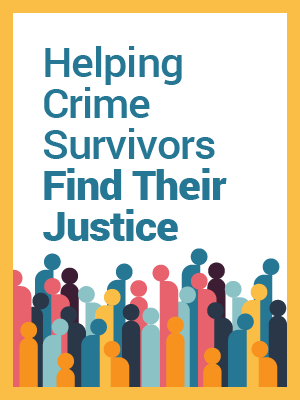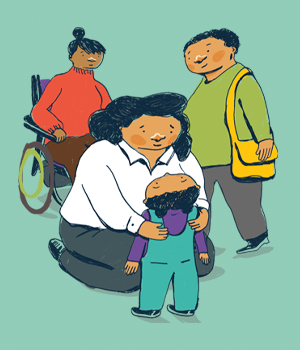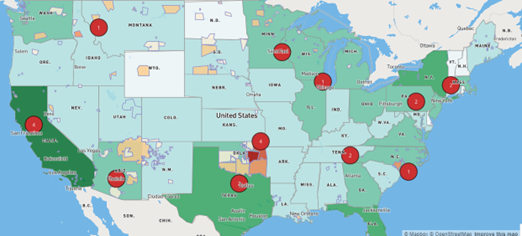Archival Notice
This is an archive page that is no longer being updated. It may contain outdated information and links may no longer function as originally intended.
Serving Victims Everywhere
OVC believes that crime victims should have access to the evidence-based services and support they need to begin their physical, emotional, and financial recovery. However, OVC recognizes that there are serious challenges to achieving this goal. Strengthening connections across allied fields to expand the availability and quality of services that impact a victim’s healing are among these challenges.
Supporting Child and Youth Victims
In the Judicial System
Children are some of the most vulnerable members of society and they are frequently victims of, or witnesses to, violence and abuse. As a result, children are often required to encounter and navigate the justice system. These systems can be intimidating, confusing, and re-traumatizing for adults, let alone for children. In 2021, OVC released Child Victims and Witnesses Support Materials offering creative, interactive, and free materials to assist children and youth, and the caregivers and professionals who help them, as they navigate the judicial system.
During National Human Trafficking Prevention Month in January 2022, OVC released supplemental materials that focused on young survivors of human trafficking. Based on the input of national experts, these materials teach child and youth victims of trafficking between the ages of 12−18 about how the justice system works; what their rights are; the roles of the different practitioners they might meet; and how they can cope with the difficult feelings they might have. Each graphic novel includes excerpts from individuals with lived experience, who offer support and information to the reader who might find themselves in a similar situation.
The materials pertaining to the criminal court and child welfare systems are available in English, Arabic, Chinese (simplified), Haitian Creole, Spanish, and Vietnamese. The materials offering support to youth victims and witnesses of human trafficking are available in English, African French, Brazilian Portuguese, Chinese (simplified), Spanish, and Vietnamese, as well as in audiobook format.
Since launch, the materials released during this performance period have been viewed more than 80,000 times.
In the Community and at Home
In FY 2019, OVC responded to research that recommended a multitude of changes consistent with an all-systems approach to resolving complex and critical issues associated with child abuse and neglect by releasing the Reducing Child Fatalities and Recurring Child Injuries solicitation. Under it, OVC awarded a total of $5.2 million in funding to five demonstration sites and one technical assistance (TA) provider.
In the first year, the demonstration sites determined a theory of change for their communities and did a 5-year retrospective review of the child death review data from their areas. Then, they developed implementation plans with strategies to keep children safe and advance toward a child and family well-being system, and sustainability and evaluation plans that would document outcomes and best practices, policies, and models for wider dissemination. An evaluation of this first year was released by the TA provider—Social Current, Inc.—in March 2021.
In year two, the demonstration sites began to pilot test equitable, community-led solutions that keep children safe and support resilient families. TA is provided by a team of national experts using expert-peer and peer-peer coaching. The TA supports sites’ improved data collection and analysis using a safety science approach, development of strong community collaboratives, engagement of persons with lived experiences, and developmental evaluation. This assistance is geared toward helping sites plan and implement an all-systems approach and coordinated strategic planning to respond to and reduce their child maltreatment fatalities and child crime victimization. During this phase, three core conditions that would lead to a strengthened child and family well-being system were identified and refined:
- Elevate families into relationships of equal power within systems.
- Build an intentional strategy to systematically assess and address racism.
- Sustain communications strategy.
In year three, technical assistance and peer learning supported iterative and adaptive implementation plans that point to changes in systems and scale, but also to more durable sustainable changes in programming and process.
In Youth Detention Facilities
Unfortunately, although the juvenile justice system is filled with youth who have endured trauma before or during their time in custody, victim services are rarely available. Few of these children are likely to have received counseling, either in detention facilities or in the community. Moreover, many youth detainees have had life experiences that cause them to feel a deep distrust of adults. Unaddressed trauma will not resolve without the help of trained professionals and will perpetuate the cycle of abuse, but youth detention facilities are less likely to have agreements in place with victim advocacy programs than adult prisons, as required under PREA, and are less likely to have conducted regular PREA audits.
It is critical for youth detention facilities to have clear policies on victim confidentiality, informed consent, and mandatory reporting requirements. Through an FY 2022 cooperative agreement, OVC funded two project sites and one TA provider to support the development and enhancement of partnerships between juvenile detention centers or jails and community-based victim service providers, with the goal of meeting juvenile survivors where they are and increasing their access to services. The training and technical assistance will focus on PREA standards, trauma and its effect on youth, adolescent development, screening protocols, supervision policies and structures, and more.
Addressing Polyvictimization
In FY 2019, OVC awarded $4.96 million through the Transforming Family Justice Center Services: Creating New Pathways of Hope and Healing for Polyvictims solicitation to build on lessons learned from an FY 2016 initiative. The TA provider, Alliance for Hope International, will engage with five Family Justice Centers (FJC)—Tulsa Family Safety Center, Sonoma FJC, New Orleans FJC, Chattanooga FJC, and Palomar—to implement the validated assessment tool; increase partnerships with traditional and nontraditional FJC services to serve identified polyvictims more holistically; expand case management services to include a thorough understanding of the specific needs of survivors; and build capacity within their communities to leverage existing and new resources for crime victims.
Demonstration sites averaged 92 partners per quarter, and an average of 68 partners per quarter used evidence-based practices. These evidence-based practices included cognitive behavioral therapy; hope therapy; and adverse childhood experiences surveys. In FY 2021 and 2022, 16,511 victims (new and returning) were served. Of those, 10,431 victims of crime were served for the first time. Domestic or family violence; adult physical assault; and stalking or harassment were the most common victimizations reported. The most common services provided were individual advocacy (23,579 occurrences); referral to other services, supports, and resources (22,293 occurrences); and referral to other victim services programs (19,401 occurrences).
Building the Capacity of National Hotlines
OVC’s Building Capacity of National Crisis Hotlines intends to enhance or expand the capacity of national victim service hotlines to provide crisis intervention support services using trauma-informed approaches that protect the safety and confidentiality of victims. In FY 2022, OVC awarded three grants for a total of $6 million.
- The National Domestic Violence Hotline is using the funding to increase access to 24/7 crisis services for victims and survivors of domestic violence, decrease wait times across hotline channels, ensure advocates are equipped with necessary information to deliver high-quality and culturally responsive services, and provide enhanced education, information, and resources on emerging domestic violence topics.
- The National Network to End Domestic Violence will enhance and expand the capacity of the national WomensLaw Email Hotline to provide legal crisis intervention support using trauma-informed approaches that protect the safety and confidentiality of victims.
- The Identity Theft Resource Center will support and train national hotline victim advisors in delivering outreach, building additional referral partners, implementing sentiment monitoring software, and expanding the national hotline resources.
Expanding Services to Victims of Domestic Violence and Sexual Assault
Housing for Domestic Violence Survivors and Their Companion Animals
OVC’s Emergency Transitional Pet Shelter Housing and Assistance Grant Program, referred to as PAWS, addresses a critical service need for victims of domestic violence: safe space for their companion animals if the victim needs to seek emergency shelter. Most domestic violence shelters are not equipped to accommodate pets, which can potentially lead to survivors delaying seeking shelter because of concerns for their pet’s welfare. PAWS addresses this gap by ensuring that shelters and transitional housing services can accommodate victims of domestic violence and their companion animals. The first 6 PAWS grantees served almost 400 victims (which includes new and returning individuals) in FY 2021. OVC has awarded a total of 23 grants under this program since FY 2020.
- FY 2020: 40 applications received; 6 awards made, totaling $2,200,968
- FY 2021: 22 applications received; 5 awards made, totaling $2,419,767
- FY 2022: 19 applications received;12 awards made, totaling $2,698,523
In FY 2021 and 2022, these grantees conducted 127 trainings for 2,155 participants representing mental health providers and legal service providers. Out of a total of 543 post-training surveys, 98 percent of participants reported overall satisfaction and 82 percent reported an increase in knowledge. These grantees collaborated with an average of 52 partners per quarter, with an average of 39 partners per quarter due to grant funding. In FY 2021 and 2022, 1,996 victims (both new and returning) were served. Of that total, 1,072 victims of crime were served for the first time. Domestic or family violence, adult physical assault, and stalking or harassment were the most common victimizations reported. The most common services provided were individual advocacy (6,056 occurrences); referral to other services, supports, and resources (1,318 occurrences); and information about the criminal justice process (1,246 occurrences).
Raising Awareness and Improving Services for Survivors of Female Genital Mutilation and Cutting
According to the Centers for Disease Control and Prevention, female genital mutilation and cutting (FGM/C) refers to procedures involving partial or total removal of female genitalia or other injury to female genital organs for non-medical reasons. In response to the estimated half a million girls and women in the United States who have either undergone FGM/C in the past or may be at risk of FGM/C in the future, OVC awarded six grants and a training and technical assistance provider totaling nearly $3 million under the Addressing Female Genital Mutilation and Cutting funding opportunity in FY 2020 and another five grants for $1.4 million in FY 2021.
In FY 2021 and 2022, 1,581 victims (both new and returning) were served. Of that total, 848 victims of crime were served for the first time. Domestic or family violence; adult sexual assault; child sexual abuse or assault; and hate crimes were the most common victimizations reported. The most common services provided were support groups (461 occurrences); individual advocacy (412 occurrences); referral to other services, supports, and resources (190 occurrences); information about victims’ rights, how to obtain notifications, etc. (166 occurrences), and interpreter services (149 occurrences).
Grantee Testimonial
“The funding allows us to provide training to frontline professionals on FGM prevention and awareness. This awareness gives frontline professionals the ability to recognize signs of, and risk factors for, FGM/C. This awareness is necessary to prevent cases involving girls at risk of FGM/C from slipping through the cracks, and address the physical and psychological complications of FGM/C.”
Access to Sexual Assault Forensic Examinations
In FY 2020, OVC awarded nearly $4 million to eight institutions to support the establishment or expansion of sexual assault nurse examiner (SANE) programs that offer medical forensic care, advocacy, and other victim services to sexual assault survivors on campuses of higher education. The Expanding SANE Services to Victims of Sexual Assault on Campus program is working to develop, expand, or strengthen SANE services to improve the delivery of post-assault medical and advocacy services. Campuses will collaborate with victim service providers in the communities in which the institutions are located. If victim services programs are not available in the community or are not accessible to students, the institution will provide a victim services program on campus in collaboration with a community-based organization.
During FYs 2021 and 2022, these grantees had an average of 166 partners per quarter involved in the initiative, with an average of 99 partners per quarter due to grant funding. There were 255 project deliverables completed and 217 improvement initiatives implemented. During these 2 years, 280 victims (both new and returning) were served. Of that total, there were 251 victims of crime served for the first time. Domestic or family violence; stalking or harassment; adult sexual assault; and adult physical assault were the most common victimizations reported. The most common services provided were information about victims’ rights, how to obtain notifications, etc. (220 occurrences); information about the criminal justice process (151 occurrences); and referral to other victim services programs (82 occurrences).
OVC awarded an additional 16 awards for a total of $10.4 million in FY 2021 and FY 2022 that focused on improving the provision of sexual assault care using a community-based approach, such as through a campus community, nonprofit, community-based, or Tribe-affiliated victim services provider. Through these funding opportunities, the International Association of Forensic Nurses was awarded more than $2.5 million to serve as the TA provider for the grantees.
In FY 2022, 1,440 victims were served, including new and returning individuals. Of that total, there were 1,265 unique victims of crime served for the first time. Domestic or family violence; adult assault or abuse; and stalking or harassment were the most common victimizations reported. The most common services provided were information about the criminal justice process (288 occurrences); information about victims’ rights, how to obtain notifications, etc. (287 occurrences), and crisis intervention (270 occurrences). The TTA provider conducted 9 trainings for 106 participants and completed 78 technical assistance requests for 205 recipients.
Domestic Violence Housing First Services
A quasi-experimental, longitudinal evaluation study followed more than 400 survivors of domestic violence, and their children, who experienced homelessness or unstable housing over a period of 2 years. Some survivors received Domestic Violence Housing First (DVHF) model services, which provide housing-related advocacy and flexible funding to help survivors achieve safe and stable housing. Others received services as usual. Key findings after 24 months were released in September 2022 and showed that domestic violence survivors with unstable housing who received the DVHF model reported a number of positive changes at 6, 12, 18, and 24 months after seeking services.
“Evidence indicates that the DVHF model is more effective than services as usual (SAU) in helping survivors achieve housing stability, safety, and improved mental health over 24 months. Survivors who received DVHF also reported higher prosocial behaviors from their children compared to parents who received SAU.” [5]
This evaluation was produced by the Washington State Coalition Against Domestic Violence and its subcontractor, Michigan State University, on behalf of the U.S. Department of Health and Human Services, Office of the Assistant Secretary for Planning and Evaluation, in partnership with OVC. Additional funding to support the evaluation was provided by the Bill & Melinda Gates Foundation to the Washington State Coalition Against Domestic Violence.
Victims of the Substance Use and Overdose Crisis
According to the Centers for Disease Control and Prevention Adverse Childhood Experiences Study, parental substance use is one adverse childhood experience associated with a range of negative outcomes later in life. Children and youth who are exposed to parental substance use may be at greater risk for crime victimization during their lifetimes, including child abuse and neglect, human trafficking, intimate partner violence, and more.
In FY 2018, OVC launched a response effort to address the urgent gaps in crime victim services related to the opioid epidemic and to establish new or expand on existing programs to provide services to children and youth who are crime victims as a result of the opioid crisis. A young victim of the substance use and overdose crisis is a child or youth, from newborn to 18 years old, who is a victim—
- of any type of crime (e.g., child abuse or neglect, physical or sexual assault, domestic or family violence, DUI or DWI) and
- impacted by the current substance use and overdose crisis (i.e., opioids, methamphetamines, other misused substances, polysubstance misuse).
OVC awarded a total of $29.8 million to 41 sites and a training and technical assistance (TTA) provider in FY 2018, and another $12.3 million to 18 sites in FY 2019. In FY 2020, OVC extended the scope of this project to children and youth who are crime victims as a result of the substance use and overdose crisis, recognizing the crisis was not limited to opioids. OVC awarded a total of $13.3 million in program grants to 17 sites and the same technical assistance provider. Examples of community responses that this program supports include school-based programs, foster care and child welfare systems, counseling and assistance programs, child advocacy programs, court-appointed special advocates, mentoring and tutoring programs, civil legal services, and faith-based programs.
In FY 2021 and 2022, there were 28,630 victims (both new and returning) served. Of those, 13,305 individuals received services for the first time. Child physical abuse, domestic and/or family violence, and child sexual abuse were the most common victimization types reported by these organizations. The most frequent services provided include individual counseling (29,332 occurrences), individual advocacy (22,794 occurrences), other therapy (20,964 occurrences), crisis intervention (15,362 occurrences), and referral to other services, supports, and resources (11,874 occurrences). Grantees involved partners in their initiatives, with an average of 944 partners involved per quarter and an average of 507 partners funded per quarter.
In FY 2021 and 2022, victim service providers also conducted 1,043 trainings for 24,503 individuals. The most common participants included community-based organizations, educators or youth service providers, and mental health providers. Participants completed 5,256 post-training surveys with 91 percent reporting overall satisfaction, 79 percent reporting an increase in knowledge, and 81 percent planning to implement the knowledge.
The TTA provider conducted 61 trainings that reached 1,461 individuals. The most common types of participants were community-based organizations, mental health providers, and victim service providers. Participants completed 303 post-training surveys, with 91 percent reporting overall satisfaction. Additionally, the TTA provider completed 1,536 technical assistance requests that supported 3,666 recipients.
Watch the 2021 National Crime Victims’ Rights Week (NCVRW) Theme Video to see the impact of this work.
In FY 2022, OVC continued work in this area through the Protecting Futures: Building Capacity to Serve Children and Youth Impacted by America’s Drug Crisis program. OVC awarded $2 million to one award recipient—JBS International—to competitively select and fund subawards that support direct services to children and youth who are crime victims impacted by the Nation’s substance use and overdose crisis and provide technical assistance to the selected subawardees.
FORGE, Inc., received a grant in FY 2022 to update and expand on the previously released 2014 OVC guide, Responding to Transgender Victims of Sexual Assault.
[note 5] Sullivan, C.M., Guerrero, M., López-Zerón, G., Simmons, C., Ayeni, O., and Chiaramonte, D. 2022. Domestic Violence Housing First Demonstration Evaluation Project: Final Report. Michigan State University. https://aspe.hhs.gov/sites/default/files/documents/589c1822f665706ce5a710a5359cef76/dvhf-24-month-technical-report.pdf.







